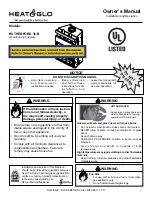
-10-
1)
Open heater door
2)
Turn GAS knob to LOW ( only)
3)
Depress knob and light burner manually ( It may be necessary to keep clicking
the lighter in order to keep the flame going to overcome the strong draft).
4)
Keep knob depressed for 20/25 seconds (once the flames will stay on). Close
heater door VERY SLOWLY as it may want to go out when the door is almost
closed (slow motion).
5)
Release knob after door is closed and flames should remain lit. (Leaving the
heater door open after ignition could cause the flame to go out when the knob is
released). Should the flames go out then turn off the gas control valve and wait a
few minutes to cool then start over.
6)
The HIGH setting may be selected after a minute or two of warm up.
Burning Characteristics
On each lighting, the heater flames will create a roaring sound for about 5 minutes until the
direct draft system stabilizes and reaches operating temperature. Initially the flame is
extremely blue and vibrant. After a short period of time the flames will increase in size and
become less vibrant with more yellow tips. This will create more of the fireplace effect.
Selecting Low or High settings will only make a small difference to the height of the flame.
However, at high the heater is burning 40% more fuel than at low and producing 40% more
heat. At the high setting the baffle at the top of the combustion chamber will glow red. This
is normal and maximizes the efficiency of the heater.
Cleaning & Maintenance
To keep the heater operating safely and trouble free, it is recommended to periodically
perform the following simple inspections:
1.
Clean the outside of the heater to maintain the shining appearance of the
stainless steel. Use a soft, non-flammable cleaning agent.
2.
Refrain from using steel wool or any metal abrasive as this leaves impurities
behind.
3.
Inspect the propane supply system and tank for age and wear.
4.
If the flame is becoming lower and lower over time or suddenly becomes very
low, inspect the orifice of the heater. Accumulations of dirt and moisture inside
the orifice can build over time and can be removed if they obstruct the orifice.

































